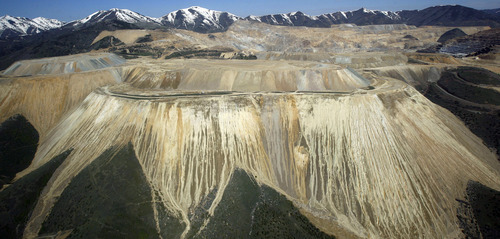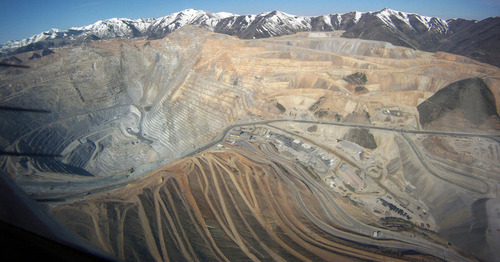This is an archived article that was published on sltrib.com in 2012, and information in the article may be outdated. It is provided only for personal research purposes and may not be reprinted.
More earth moving at U.S. mines meant a big boost in toxic chemicals released into the nation's air, land and water, according to the latest data.
The U.S. Environmental Protection Agency said Thursday that government and industry reported nearly 4 billion pounds in the latest Toxics Release Inventory, a tally for 2010. The overall increase was 16 percent from the previous year, much of it thanks to changes at Kennecott Utah Copper's Bingham Canyon and the nation's other big mining operations.
Kennecott's concentrators and power plant on the western edge of Utah's most populated county ranked fourth nationally for TRI releases, with nearly 161 million pounds of reported releases. Separately, the company's smelter and refinery ranked 12th nationally, with more than 32 million pounds of reported releases. If counted together, the Kennecott facilities would be ranked third behind mines in Alaska and Nevada.
Kennecott spokesman Kyle Bennett pointed out that the EPA counts ore and overburden for the annual inventory because it contains trace amounts of lead, zinc, copper and other toxic metals.
"On a daily basis," he said, "we move approximately 188,000 tons of copper ore and 340,000 tons of overburden" — the rock and dirt on top of the copper.
"Each day!" added Chris Lilly, an environmental specialist for the company.
"That's why we rank high on the list" Bennett continued, "because we move a lot of material. The numbers add up."
Pointing to the company's ongoing efforts to clean up all of its operations, such as the $880 million spent to remove pollutants from smelter operations, Bennett added: "We have a history of investing in improvements."
Primarily because of Bingham Canyon, Utah ranked third among states for overall TRI releases, behind Alaska and Nevada. And Salt Lake County ranked third among counties.
The only other Utah facility on the nation's top-100 list is US Magnesium Corp., which ranked 88 in 2010 after dropping off the list for much of the last decade. Before more than $50 million in upgrades, the magnesium-processing plant on the southwestern edge of the Great Salt Lake was notorious as the nation's biggest air polluter and more recently was declared a Superfund cleanup site.
Said G. Tom Tripp, the company's technical services manager: "I'm a little surprised to be back on the list at all."
And the company is second nationally for the total dioxin reported (there are more than two dozen forms of the chemical). But a new TRI tally that considers dioxin toxicity does not include US Magnesium in the top 100.
"We will continue to put accessible, meaningful information in the hands of the American people," said EPA Administrator Lisa P. Jackson in a news release. "Widespread public access to environmental information is fundamental to the work EPA does every day."
Also on the latest top-10 list for the nation is a Pensacola, Fla., petrochemical plant owned by Salt Lake City-based Huntsman Corp. It is ranked sixth nationally in TRI releases, but company spokeswoman Anne Knisely said her company would not comment since it had not had the opportunity to review the newly released data.
In Utah, TRI releases overall grew 46 percent in 2010 from the previous year. Not counting Kennecott's releases, the total increased just over 11 percent. (A chart accompanying this article reflects the year-to-year totals in Utah without mining releases — including Kennecott's — whose inclusion would skew longer-term comparisons because they weren't counted by EPA until 2001.)
The total amount of toxic chemicals reported in Utah was nearly 212 million pounds, or more than 76 pounds per person, according to the latest EPA data.
Cherise Udell, a founder of Utah Moms for Clean Air and an outspoken critic of Kennecott's plans to expand the Bingham Canyon mine, said the latest statistics reaffirm her group's commitment to forcing Kennecott to take responsibility for the true cost of doing business, including the cost to health and the environment.
"It's shocking to realize that one of our local companies is in the top three, although I'm not surprised," she said.
"While these are spreadsheet numbers," she added, "they equal human suffering, and the more toxic chemicals released into the environment, the more suffering" Utahns will experience in neurological disorders, heart ailments, cancer, respiratory illness and other health impacts.
fahys@sltrib.comTwitter: judyfutah —
Your right to know
The U.S. Environmental Protection Agency makes toxic chemical reports available online, and learning more about releases nationwide, in your state and even in your neighborhood is easy. Here's a link: http://www.epa.gov/tri/.





